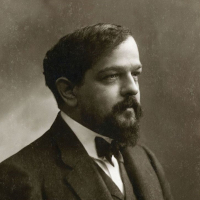


Claude Debussy
Sonate pour ensemble
Short instrumentation: 1 1 1 1 - 0 1 1 1 - perc(2), hp, alto sax(Eb), str(max. 6 6 4 4 2; min. 1 1 1 1 1)
Duration: 13'
Bearbeitet von: Roland Freisitzer
Instrumentation details:
flute (+picc)
cor anglais
clarinet in Bb (+bass cl(Bb))
alto saxophone in Eb
bassoon (+cbsn)
trumpet in C
trombone
tuba
percussion(2)
harp
violin I(6)
violin II(6)
viola(4)
violoncello(4)
double bass(2)
‘The Cello Sonata by Claude Debussy is, in my opinion, one of the most interesting and best chamber music works of the first half of the 20th century. The treatment of the cello and the piano surpasses the idea of "for cello with piano accompaniment" in that it is an interplay of chamber music between two absolutely equal musicians, even if only the cello may shine with cadenzas. During my time as a student, when we were allowed to orchestrate all kinds of pieces at the Moscow Conservatory in instrumentation lessons, I had a great desire to orchestrate this piece, but it did not happen at that time.
Asked by Peter Keuschnig for arrangements of French works of the 20th century for his Ensemble Kontrapunkte, I proposed the "Sonate pour violoncelle et piano" by Claude Debussy. It was clear to me from the outset that I did not want to make any instrumentation for violoncello with accompanying ensemble, simply because the piano has no accompanying function, as in Debussy's Violin Sonata, for example, where this conventional role is present.
With my instrumentation, I wanted to try to create a soundscape that would be as similar as possible to that which Claude Debussy would have heard in 2019. This meant also permitting combinations that would perhaps be anachronistic in the sense of having the most "authentic" instrumentation possible, yet with clear references. In addition, the role of the solo cello is of course not present. The solos of the cello are divided into ensembles, although the respective celloist/cellist will have some déjà vu experiences...
For this I have chosen the following cast: Flute (also piccolo), English horn, clarinet (also bass clarinet), saxophone (alto or tenor), bassoon (also contrabassoon), trumpet, trombone, tuba (the three brass players use mutes throughout), harp, percussion and string quintet (which can also be chorus).’
Roland Freisitzer
